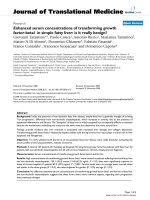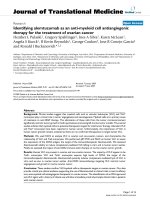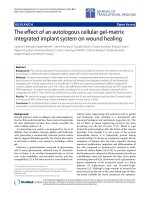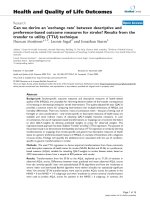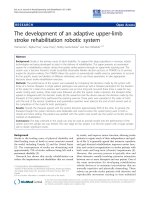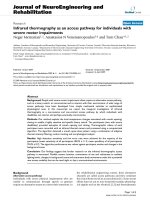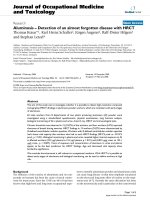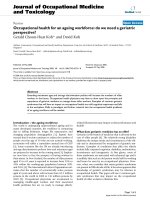Báo cáo hóa học: " Enhanced photo-sensitivity through an increased light-trapping on Si by surface nano-structuring using MWCNT etch mask" pptx
Bạn đang xem bản rút gọn của tài liệu. Xem và tải ngay bản đầy đủ của tài liệu tại đây (722.47 KB, 8 trang )
NANO EXPRESS Open Access
Enhanced photo-sensitivity through an increased
light-trapping on Si by surface nano-structuring
using MWCNT etch mask
Min-Young Hwang
1
, Hyungsuk Kim
1
, Eun-Soo Kim
1
, Jihoon Lee
1,2*
and Sang-Mo Koo
1*
Abstract
We demonstrate an enhanced photo-sensitivity (PS) through an increased light-trapping using surface nano-
structuring technique by inductively coupled plasma (ICP) etching on multi-walled carbon nanotube (MWCNT) etch
masked Si with hexamethyl-disilazane (HMDS) dispersion. In order for a systematic comparison, four samples are
prepared, respectively, by conventional photolithography and ICP etching using MWCNT as a etch mask. MWCNT-
etched Si with HMDS dispersion shows the highest RMS roughness and the lowest reflectance of the four. Two
test device structures are fabricated with active regions of bare-Si as a reference and MWCNT etch masked Si with
HMDS dispersion. The increased light-trapping was most significant at mid-UV, somewhat less at visibl e and less
noticeable at infrared. With an ICP-etched Si using CNT HMDS dispersion, PS is very sharply increased. This result
can lead to applications in optoelectronics where the enhancement in light-trapping is importa nt.
Introduction
Light-trappi ng, in other word optical absorption, in such
device applications as photovoltaics, light-emitting
diodes, light sensors, photo-diodes, and transistors, plays
an important role in their device functionality and in
order to suppress reflection losses and increase conver-
sion efficiency [1-10 ]. In general, approxi matel y 30-40%
of photons are reflected when incident on planar wafers.
Theoretically, through an ideal light-trapping the length
of optical path in a material with a refractive index of n
can be enhanced by a factor of 4n
2
[11], and thus the
amount of photons that can be absorbed in a material
can be significantly enhanced. Various light-trapping
techniques therefore have been explored and developed
to restrain the reflection losses and enhance optical
absorption in various applications. For example, in
photovoltaic applications a thin film known as an antire-
flection coating can be adapted, which has a r efractive
index that is intermediate between those of semiconduc-
tors (n
s
)andair(n
0
)[11].TiO
2
(n =2.3),Ta
2
O
5
(n =
2.25), Si
3
N
4
( n =2.0),Al
2
O
3
( n =1.85),SiO
2
( n =1.5),
and MgF
2
(n = 1.38) are widely known materials that can
be use d for a ntireflection coatings [8]. On the other
hand, surface patt erning or texturing instead of planar
substrates have been widely investigated and adapted in
ordertohandlelight-trappinginamoreefficientway
[12-14]. Patterns that can be used in surface texturing
can be either regular or random. A regularly textured
surface can be yield with vari ous types of patterns [3,5,6]
using convent ional photolithography. Randomly textured
surfaces have been demonstrated [4,7-10] using SnO
2
,
ZnO, Ag, glass, and plastics, which showed an improved
spectral response in longer wavelengths. Meanwhile,
CNTs have bee n widely proposed in composite materials
to reinforce the mechanical strength and catalytic activ-
ities [15-21], which varies from metals, metal oxides, and
ceramic composites to polymers. CNTs can also be used
in various applications such as an emitter for the field
effect displays, micro-supercapacitors, color fine-tuning,
electrochemical sensors and hydrogen storage, etc.
[22-29]. On the other hand, due to their superior
mechanical strength, CNTs ca n be used as a etch mask
in plasma dry-etching process [30]. While etch masks
through conventional photolithography process can gen-
erate micron-scale patterns, CNT etch mask technique
can provide nanoscale surface patterns as observed by
microscopy [31-33].
* Correspondence: ;
1
College of Electronics and Information, Kwangwoon University, Nowon-gu
Seoul 139-701, South Korea
Full list of author information is available at the end of the article
Hwang et al. Nanoscale Research Letters 2011, 6:573
/>© 2011 Hwang et al; licensee Springer. This is an Op en Access article distribute d under the terms of the Creative Commons Attribution
License ( /licenses /by/2 .0), which permits unre stricted use, distribution, and reproduction in any medium,
provided the original work is properly cited.
In this letter, we demonstrate an enhanced photo-sensi-
tivity (PS) through an increased light-trapping on Si, which
is achieved by increasing surface roughness and suppres-
sing reflection losses through a surface nano-texturing
using inductively coupled plasma (ICP) etching. Four Si
samples are prepared using conventional photolithography
and ICP etching using multi-walled carbon nanotubes
(MWCNT). MWCNTs dispersed in hexamethyl-disilazane
(HMDS) were used as an etch mask for the ICP etching.
The highest RMS roughness with a value of 7.66 nm and
thus the lowest reflectance by 41.5% at mid-UV are
achieved with the ICP-etched Si using MWCNT etc h
mask. The increased light-trapping is most significant at
mid-UV, less at visible, and finally somewhat insignificant
at inf rared region. Based on the RMS rough ness and reflec-
tance analyses, tw o I-V test device structures are fabricated.
Device active re gion using bare-Si is set as a reference
while ICP-etched Si using MWCNT etch mask is fabri-
cated for a PS comparison. With an ICP-etched Si with
HMDS dispersion, PS at UV illumination is very sharply
increased through back-to-back Schottky-barriers.
Experimental details
In this experiment, in order to perform surface mor phol-
ogy, RMS roughness, and reflectance analyses, four Si
samples were prepared: bare-Si (sample A), square trench-
patterned Si using conventional wet chemical etching
(sample B), ICP-etched Si using MWCNT-dispersion in
isopropyl-alcohol (sample C), and another ICP-etched Si
using MWCNT-dispersion in HMDS (sample D). For the
preparation of sample A, a conventional cleaning proce-
dure using acetone and methanol was performed. For
sample B, a pattern area of 3 × 3 μm
2
was fabricated using
conventional photolithography and wet chemical etching;
namely chemical cleaning using H
2
SO
4
:H
2
O
2
=1:1and
HF, photo-resist (PR) spin coating, baking, UV exposure
and development, etc. After the patterning, 50 nm of Si
was removed using HNO
3
:HF:DI = 100:3:40. For the pre-
paration of ICP-etched Si, MWCNTs (MWCNTs) with a
diameter of 10-15 nm were used (Hanhwa nanotech Co.,
Korea), which were grown using a chemical vapor deposi-
tion. For the preparation of one ICP-etched Si sample
(sampl e C), initially approximately 13.5 mg of MWCNTs
was dispersed in approximately 200 mL of isopropyl-alco-
hol. The mixed solution was then dropped on a Si surface
and the sample was dried in air. Subsequently, the sample
was heated on a hot-plate at 120°C for 2 min to fix the
MWCNTs. For the preparation of the other ICP-etched Si
(sample D), MWCNTs were dispersed in HMDS for an
improved dispersion. For the samples C and D, 50 nm of
Si was subsequently etch ed away using ICP dry-etching
with an ambient gas mixture of SF
6
:O
2
(20:4%) at a cham-
ber pressure of 30 mTorr and RF power of 30 W. Fol-
lowed by the dry-etching, samples were cleaned in a
boiled acetone at 120°C for 5 min and in a methanol and
finally rinsed in DI water (boiling temperature of acetone
is 56°C). Based on the analyses, two test device structures
were consequently fabricated using bare-Si and an ICP-
etched Si using MWCNT dispersed in HMDS for a com-
parisonofPS.Ansilicononinsulator(SOI)waferwas
used for the device fabrication, which included 350 μmof
p-type Si with a doping of 10
17
cm
-3
, 100 nm of SiO
2
,and
another 100 nm thick p-type Si at the top with a doping of
10
17
cm
-3
. Both test structures were exactly the same
except the active regions: bare-Si for one and ICP-etched
Si for the other. For the contacts, Schottky-barrier of Cr/
Ag (50/50 nm) was fabricated on the top layer using con-
ventional photolithography and an e-beam evaporation at
approximately 3 × 10
-5
Torr at approximately 150°C. For
the measurements of surface morphology, an atomic force
microscope (AFM, N8 ARGOS, B ruker AXS Inc.) was
used in air with a non-contact mode. Reflectance was
measured using Avaspec-3648 and halogen and deuterium
lamps were used for light sources. For the I-V characteri-
zation, Keithley Semiconductor Characterization System
(SCS-4200) was used under dark and at illumination
(approximately 200 nm) with a power density of approxi-
mately 137 mW/cm
2
.
Results and discussion
Figure 1 shows three-dimensional (3D) AFM images of
four S i samples wit h 7 (x)×7(y) μm
2
area. Figure 1a
shows a bare-Si surface (sample A) and Figure 1b shows a
square tr ench pattern on Si with an area of 3 × 3 μm
2
using conventional photolithography (sample B).
MWCNT etch masked Si surface with the dispersion in
isopropyl-alcohol (sample C) is presented in Figure 1c
and 1 similarly MWCNT etch masked Si with a HMDS
dispersion (sample D) is shown in Figure 1d. Figure 2
shows two-dimensional (2D) AFM top-views in the first
column, 3D AFM side-views in the second column, and
corresponding line-profiles in the third column of t he
representing structures of each sample. The x-axis in line-
profiles represents the length and y-axis corresponds to
the height along the line-profilers, which are indicated as
white lines in the 2D AFM images. In all line-profiles,
height (y-axis) is set to be equal in order for a clearer con-
trast. As seen in Figures 1a and 2a and a-1, sample A is
fairly flat an d there appears no distinctive str ucture with
just micron-scale surface ripples. As clearly seen in the
line-profile in Figure 2a-2, this surface is relatively very flat
as compared to the other three. As seen in Figures 1b and
2b, b-1 and b-2, the sizes of trench squares are approxi-
mately 3 × 3 μm
2
at the top and approximately 2 × 2 μm
2
at the bottom. The square trench is approximately 50 nm
deep as clearly seen in Figure 2b-2 and the bottom area of
trench is roughened. As clearly seen in Figures 1c and 2c,
c-1 and c-2, mound-like nano-structures appeared after an
Hwang et al. Nanoscale Research Letters 2011, 6:573
/>Page 2 of 8
ICP etching, which can be likely due to an aggregation of
MWCNTs [18-20] during the dry process. Average size of
nano-mounds was approximately 45 nm in height and
approximately 600 nm in length and average density of
nano-mounds was 1.2 × 10
7
cm
-2
as seen in Figures 1c
and 2c. With HMDS dispersion, the resulting surface after
an ICP etching showed a much improved result as seen in
Figures 1d and 2d and d-1. Line-like features can be
clearly observed in Figures 1d and 2d, which was con-
structed by shadowing of MWCNTs during the ICP etch-
ing. Nevertheless, smaller mounds due to aggregation of
MWCNTswerestillobservedandthesizeofnano-
mounds was smaller ran ging approximat ely 10-20 nm in
height and approximately 200-400 nm in diameter.
Figure 3 presents root mean squar e (RMS) roughness
(RMSR) analysis of sample A -D in Figure 3a and reflec-
tance measurement in Figure 3b. Y-axis shows RM S
roughness in nano-meter in Figure 3a and reflectance in %
in Figure 3b. X-axis in Figure 3a, b indicates the four sam-
ples as labeled at the top of Figure 3a. The spectral region
is mid-UV in Figure 3b. Overall, the RMSR analysis well
matches with the AFM morphology ana lyses in Figures 1
and 2, i.e., the MWCNT etch-masked Si surface with
HMDS dispersion (sample D) showed the highest RMRS
and thus the roughest surface of the four. As can be
expected from the AFM morphology analy sis, sample D
showed highest degree of roughness with a n RMSR of
7.66 nm while sample A showed the lowest roughness
with an RMSR of 1.41 nm. Sample B had an RMSR of
3.4nmandsampleCshowedanRMSRof6.56nm,
respectively. In comparison with the RMSR analysis, the
reflectance acquired with an illumination at approximately
200 nm is plotted in Figure 3b and the reflectance of sam-
ple A (bare-Si) was set as 100% for a reference. Overall,
the reflectance measurement also well matched with the
AFM morpho logy and RMSR anal yses. Namely, the sam-
ple D showed the lowest lev el of reflectance with a value
of approximately 40%, indicating this surface possesses the
highest light-trapping of the four samples. Meanwhile, the
sample B showed a reflectance value of approximately 88%
and sample C showed approximately 60%. Figure 4 shows
the reflectance over common spectral regions versus sam-
ples, which in cludes UV, v isible, and infrared. O ver the
200-1000 nm spectral range, samples B-D showed a simi-
lar behavior: lowest reflectance at UV regions, somewhat
higher at visible, and highest at infrared. This can indicate
Figure 1 (a) 3D AFM images of bare-Si. (b) Conventional wet chemical etched Si using square masks. (c) ICP-etched Si surface using MWCNT-
dispersion in isopropyl-alcohol. (d) ICP-etched Si using MWCNT-dispersion in HMDS. 3D AFM images in (a-d) are 7 (x)×7(y) μm
2
.
Hwang et al. Nanoscale Research Letters 2011, 6:573
/>Page 3 of 8
that the surface nano-structuring by ICP etching using
MWCNT etch mask provides surface patterns that are
sensitive to photons of shorter wavelengths. With a larger
wavelength, the reflectance is expected to be less affected
by the surface roughness as the wavelength becomes
comparable with the surface features. Overall, the sample
D showed the highest RMSR and lowest reflectance, espe-
cially sig nificant at UV.
In order to compare the efficiency of light-trapping,
two device structures were fabricated. Figure 5 shows the
Figure 2 2D and 3D views of AFM images and cross-sectional line-profiles of: (a).bare-Si,(b)conventional wet chemical et ching of
square-masked Si, (c) ICP-etched Si using MWCNT-dispersion in isopropyl-alcoholand (d) ICP-etched Si using MWCNT-dispersion in HMDS.
Corresponding line-profilers are indicated as white lines in 2D AFM images with the corresponding alphabetical letters in (a-d). 2D and 3D AFM
images are 4 (x)×4(y) μm
2
.
Hwang et al. Nanoscale Research Letters 2011, 6:573
/>Page 4 of 8
two test device structures: reference structure using bare-
Si in Figure 5a and MWCNT etch-masked Si with
HMDS dispersion in Figure 5b. Both structures were fab-
ricated for the same dimensions except the active regions
(top layer). For the reference device, bare-Si with the
highest reflection was used and for the other, MWCNT
etch-masked Si with HMDS dispersion with the lowest
reflection was used. For the contacts, Schottky-barriers of
Cr/Ag (50/50 nm) were fabricated for both devices an d
the con tacts were made afte r ICP etching for the
Figure 3 (a) Plots of RMS roughness and (b) photo
reflectanceof bare-Si, conventional wet chemical-etched Si
using square masks, ICP-etched Si using MWCNT-dispersion in
isopropyl-alcohol and ICP-etched Si using MWCNT-dispersion
in HMDS. The reflectance of bare-Si is set as a reference (100%).
The spectral region is mid-UV in (b).
Figure 4 Plots of photo reflectance versus samples over
common spectral regions; mid-UV, near-UV, visible, near-
infrared, and mid-infrared. The decrease in photo reflectance is
most significant at UV, less at visible, and finally somewhat
insignificant at infrared.
Hwang et al. Nanoscale Research Letters 2011, 6:573
/>Page 5 of 8
MWCNT etch-masked device due to the CNT dispersion
process. Figure 6 shows the I-V characteristic of both
structures: reference device in Figure 6a and MWCNT
etch-masked Si in Figure 6b. In Figure 6, black dots and
triangles show dark current and white ones show current
at UV illumination. At both cases, in general there
appeared almost no (or very small) current under dark as
can be expected. This shows that the current flow is
regardless of the applied voltage under dark due to back-
to-back Schottky-barriers, which is a common configura-
tion of drain and source for SOI field-effect transistor.
With an UV illumination, both devices showed sharp
increases of current as voltage was inc reased. This can
indicate that the optically generated carriers were swept
down due to a tiled potential and the degree of the tilt is
obviously as a function of an applied voltage. As clearly
seen in Figure 6, the trends of current incr ease appear to
be quire very similar. The current level with MWCNT
etch-masked device is approximately two orders lower
and this can be likely due to the fabrication of contacts
after the ICP etching as mentioned a bove. In order to
compare the effectiveness of light-trapping, PS of both
devices is plotted in Figure 7. PS indicates a ratio of the
current change at UV-illumination over the current
under dark. Black dots indicate the PS of MWCNT etch-
masked Si with HMDS dispersion while white ones are
acquired from reference structure. In general, the CNT
etch-masked device showed much enhanced PS, i.e., the
ratio of UV-induced carriers was over 300 at 0.1 V and
very sharply increased to over 1200 at 3.3 V. The
increased PS can be due t o the increased surface rough-
ness and d ecreased reflec tance and th us the increased
light-trapping. Then the PS began to decrease at 3.3 V,
indicat ing the maximum PS was approximately 1200. For
the reference structure, the PS was initially somewhat
higher ranging approximately 100 over 0.1-1 V and then
decreased to several tens to approximately 10 over 1-3 V,
indicating the PS was insignificant or the light was mostly
reflected.
Conclusions
In conclusion, to test light-trapping of Si, four samples
were prepared: bare-Si, square masked-pattern,
MWCNT etch-masked Si with isopropyl-alcohol
Figure 5 Schematic descriptions of test device structures for I-
V measurement. (a) a reference device structure with an active
region using bare-Siand (b) comparing device structure with an
active region using ICP-etched Si with MWCNT dispersion in HMDS.
Except the last P-Si layer, everything else is fabricated to be the
same.
Figure 6 Plots of I -V measurements under dark (black) and at
UV illumination (white) of: (a). the reference device structure and
(b) ICP-etched Si structure using MWCNT-dispersion in HMDS.
Hwang et al. Nanoscale Research Letters 2011, 6:573
/>Page 6 of 8
dispersion, and MWCNT etch-masked Si with HMDS
dispersion. The MWCNT e tch-masked Si with HMDS
dispersion (sample D) showed the height RMS r ough-
ness and lowest reflectance as compared to the other
three tested Si samples. The reflectance was most signif-
icant at mid-UV region and less significant at infrared.
Based on the RMS roughness and reflectance experi-
ments, two device structures were fabricate d with active
regions of bare-Si and CNT etch-masked Si and tested
under dark and at UV illumination. While both devices
showed a similar behavior indicating increased current
at UV illumination, the PS indicating the ratio of the
current change at UV-illumination over the current
under dark much sharply increased with the test device
of CNT etch-masked Si. The increased photo response
can be due to the increased surface roughness and
decreased reflectance and thus the i ncreased light-trap-
ping. This result can find applications in such devices as
photovoltaics, light-emitting diodes, photo-diodes, and
photo-transistors, where the light-tramping is important.
Abbreviations
AFM: atomic force microscope; CNT: carbon nanotube; HMDS: hexamethyl-
disilazane; ICP: inductively coupled plasma; MWCNT: multi-walled carbon
nanotube; PR: photo-resist.
Acknowledgements
This study was supported by the National Research Foundation of Korea
Grant funded in part by the Korean Government (2010-0015360), (2011-
0004804), and (2011-0030821). This research has been conducted in part by
the research grant of Kwangwoon University in 2011. This research was
supported in part by the MKE (The Ministry of Knowledge Economy), Korea,
under the ITRC (Information Technology Research Center) support program
supervised by the NIPA (National IT Industry Promotion Agency) (NIPA-2011-
C1090-1111-0002).
Author details
1
College of Electronics and Information, Kwangwoon University, Nowon-gu
Seoul 139-701, South Korea
2
Institute of Nanoscale Science and Engineering,
University of Arkansas, Fayetteville, AR 72701, USA
Authors’ contributions
MYH & SMK participated in the experiment design, carried out the
experiments. HSK, ESK, JHL, and SMK designed the experiments and testing
methods. All authors helped to draft the manuscript and read and approved
the final manuscript.
Competing interests
The authors declare that they have no competing interests.
Received: 1 August 2011 Accepted: 31 October 2011
Published: 31 October 2011
References
1. Zhu J, Hsu C-M, Yu Z, Fan S, Cui Y: Nanodome solar cells with efficient
light management and self-cleaning. Nano Lett 2010, 10:1979.
2. Selvana JAA, Delahoya AE, Guoa S, Li Y-M: A new light trapping TCO for
nc-Si:H solar cells. Sol Energy Mater Sol Cell 2006, 90:3371.
3. Mokkapati S, Beck FJ, Polman A, Catchpole KR: Designing periodic arrays
of metal nanoparticles for light-trapping applications in solar cells. Appl
Phys Lett 2009, 95:053115.
4. Sai H, Kondo M: Effect of self-orderly textured back reflectors on light
trapping in thin-film microcrystalline silicon solar cells. J Appl Phys 2009,
105:094511.
5. Zhao L, Zuo YH, Zhou CL, Li HL, Diao HW, Wang WJ: A highly efficient
light-trapping structure for thin-film silicon solar cells. Sol Energy 2010,
84:110.
6. Shih H-F, Hsieh S-J, Liao W-Y: Improvement of the light-trapping effect
using a subwavelength-structured optical disk. Appl Opt 2009, 48:F49.
7. Sheng X, Liu J, Coronel N, Agarwal AM, Michel J, Kimerling LC: Integration
of self-assembled porous alumina and distributed bragg reflector for
light trapping in Si photovoltaic devices. IEEE Photon Techonol Lett 2010,
22:1394.
8. Huang C-Y, Wang D-Y, Wang C-H, Chen Y-T, Wang Y-T, Jiang Y-T, Yang Y-J,
Chen C-C, Chen Y-F: Efficient light harvesting by photon downconversion
and light trapping in hybrid ZnS nanoparticles/Si nanotips solar cells.
ACS Nano 2010, 4:5849.
9. Hsu C-M, Lin H-B, Wu W-T: Surface textured molybdenum zinc oxide for
light diffusion enhancement. Thin Solid Film 2009, 517:3717.
10. Iyengar VV, Nayak BK, Gupta MC: Optical properties of silicon light
trapping structures for photovoltaics. Sol Energy Mater Sol Cell 2010,
94:2251.
11. Green MA: Silicon Solar Cells: Advanced Principles and Practice Sydney,
Australia: The University of New South Wales; 1995.
12. Vygranenko Y, Nathan A, Vieira M, Sazonov A: Phototransistor with
nanocrystalline Si/amorphous Si bilayer channel. Appl Phys Lett 2010,
96:173507.
13. Zhou H, Fang G, Yuan L, Wang C, Yang X, Huang H, Zhou C, Zhao X: Deep
ultraviolet and near infrared photodiode based on n-ZnO/p-silicon
nanowire heterojunction fabricated at low temperature. Appl Phys Lett
2009, 94:013503.
14. Creasey M, Li X, Lee JH, Wang ZM, Salamo GJ: Strongly confined excitons
in self-assembled InGaAs quantum dot clusters produced by a hybrid
growth method. J Appl Phys 2010, 107:104302.
15. Spinks GM, Shin SR, Wallace GG, Whitten PG, Kimb SI, Kim SJ: Mechanical
properties of chitosan/CNT microfibers obtained with improved
dispersion. Sens Actuator B
2006, 115:678.
16.
Miaudet P, Derré A, Maugey M, Zakri C, Piccione PM, Inoubli R, Poulin P:
Shape and temperature memory of nanocomposites with broadened
glass transition. Science 2007, 318:1294.
17. Park J-M, Kim P-G, Jang J-H, Wang Z, Kim J-W, Lee W-I, Park J-G, DeVries KL:
Self-sensing and dispersive evaluation of single carbon fiber/carbon
nanotube (CNT)-epoxy composites using electro-micromechanical
technique and nondestructive acoustic emission. Composites B 2008,
39:1170.
18. Dzenis Y: Structural nanocomposites. Science 2008, 319:419.
Figure 7 Plot of PS indicating the ratio of the current at UV-
illumination over the current under dark of the reference
device and ICP-etched Si device. ICP-etched Si device shows a
much higher PS (black dots), indicating a much enhanced light-
trapping of MWCNT masked Si under UV illumination.
Hwang et al. Nanoscale Research Letters 2011, 6:573
/>Page 7 of 8
19. Sharma A, Kumar S, Tripathi B, Singh M, Vijay YK: Aligned CNT/Polymer
nanocomposite membranes for hydrogen separation. Int J Hydrogen
Energy 2009, 34:3977.
20. Wijewardane S: Potential applicability of CNT and CNT/composites to
implement ASEC concept: a review article. Sol Energy 2009, 83:1379.
21. Zhanga D, Maia H, Huangb L, Shi L: Pyridine-thermal synthesis and high
catalytic activity of CeO2/CuO/CNT nanocomposites. Appl Surf Sci 2010,
256:6795.
22. Tatami J, Katashima T, Komeya K, Meguro T, Wakihara T: Electrically
conductive CNT-dispersed silicon nitride ceramics. J Am Ceram Soc 2005,
88(10):2889.
23. Show Y, Itabashi H: Electrically conductive material made from CNT and
PTFE. Diam Relat Mater 2008, 17:602.
24. Chmiola J, Largeot C, Taberna P-L, Simon P, Gogotsi Y: Monolithic carbide-
derived carbon films for micro-supercapacitors. Science 2010, 328:480.
25. Zhao X, Meng G, Xu Q, Han F, Huang Q: Color fine-tuning of CNTs@AAO
composite thin films via isotropically etching porous AAO before CNT
growth and color modification by water infusion. Adv Mater 2010,
22:2637.
26. Chen Y-S, Huang J-H: Arrayed CNT-Ni nanocomposites grown directly on
Si substrate for amperometric detection of ethanol. Biosens Bioelectron
2010, 26:207.
27. Choi C-Y, Lee J-H, Koh J-H, Ha J-G, Koo S-M, Kim S: High-temperature
stable operation of nanoribbon field-effect transistors. Nanoscale Res Lett
2010, 5:1795.
28. O’Driscoll NJ, Messier T, Robertson MD, Murimboh J: Suspension of multi-
walled carbon nanotubes (CNTs) in freshwaters: examining the effect of
CNT size. Water Air Soil Pollut 2010, 208:235.
29. Lo A-Y, Liu S-B, Kuo C-T: Effect of temperature gradient direction in the
catalyst nanoparticle on CNTs growth mode. Nanoscale Res Lett 2010,
5:1393.
30. Yun WS, Kim J, Park K-H, Ha JS, Ko Y-J, Park K, Kim SK, Doh Y-J, Lee H-J,
Salvetat J-P, Forró L: Fabrication of metal nanowire using carbon
nanotube as a mask. J Vac Sci Technol A 2000, 18:1329.
31. Merola F, Miccio L, Coppola S, Vespini V, Paturzo M, Grilli S, Ferraro P:
Exploring the capabilities of digital holography as tool for testing optical
microstructures. 3D Res 2011, 02:01003.
32. Mann CJ, Bingham PR, Lin HK, Paquit VC, Gleason SS: Dual modality live
cell imaging with multiple-wavelength digital holography and epi-
fluorescence. 3D Res 2011, 02
:01005.
33. Pandey N, Hennelly B: Effect of additive noise on phase measurement in
digital holographic microscopy. 3D Res 2011, 02:01006.
doi:10.1186/1556-276X-6-573
Cite this article as: Hwang et al.: Enhanced photo-sensitivity through an
increased light-trapping on Si by surface nano-structuring using
MWCNT etch mask. Nanoscale Research Letters 2011 6:573.
Submit your manuscript to a
journal and benefi t from:
7 Convenient online submission
7 Rigorous peer review
7 Immediate publication on acceptance
7 Open access: articles freely available online
7 High visibility within the fi eld
7 Retaining the copyright to your article
Submit your next manuscript at 7 springeropen.com
Hwang et al. Nanoscale Research Letters 2011, 6:573
/>Page 8 of 8
